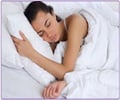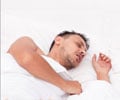An increased risk of heart-related deaths is seen in elderly men who experience extensive episodes of interrupted breathing while asleep. This is due to poor blood oxygenation.

‘The risk of heart-related death increased by 59 percent when the men slept for 12 or more minutes at low oxygen saturation (below 90 percent).’





"Understanding underlying causes of low oxygen saturation during sleep is important as this may assist in preventing deaths," says Associate Professor Linz. "The study shows for the first time that poor blood oxygenation during sleep predicts the chance of heart-related death in elderly men. The study also demonstrates that reduced blood oxygenation cannot be attributed to episodic drops in oxygen alone."
A healthy person normally has a 95-100 per cent saturation during the day. Oxygen saturation is slightly lower while a person sleeps due to shallower breathing. Saturation below 90 per cent is considered low resulting in hypoxia where oxygen flow to the body is restricted.
"The study showed that when the men had 12 or more minutes of sleep at low oxygen saturation below 90 per cent this increased the risk of heart-related death by 59 per cent," says Associate Professor Baumert.
"Approximately 20 per cent of the time that oxygen saturation was below 90 per cent could not be attributed to episodic desaturations traditionally related to sleep-disordered breathing."
Advertisement
"Simple and affordable tools for overnight measurement of hypoxia levels are readily available. Tests can be performed at home or aged care facilities as part of a standard health check program," says Associate Professor Baumert.
Advertisement
Source-Eurekalert















